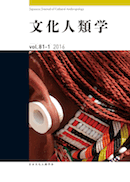Volume 72, Issue 4
Displaying 1-25 of 25 articles from this issue
- |<
- <
- 1
- >
- >|
-
Article type: Cover
2008Volume 72Issue 4 Pages Cover1-
Published: March 31, 2008
Released on J-STAGE: August 21, 2017
Download PDF (39K) -
Article type: Cover
2008Volume 72Issue 4 Pages Cover2-
Published: March 31, 2008
Released on J-STAGE: August 21, 2017
Download PDF (39K) -
Article type: Appendix
2008Volume 72Issue 4 Pages App1-
Published: March 31, 2008
Released on J-STAGE: August 21, 2017
Download PDF (72K) -
Article type: Article
2008Volume 72Issue 4 Pages 445-465
Published: March 31, 2008
Released on J-STAGE: August 21, 2017
Download PDF (2253K) -
Article type: Article
2008Volume 72Issue 4 Pages 466-484
Published: March 31, 2008
Released on J-STAGE: August 21, 2017
Download PDF (1978K) -
Article type: Article
2008Volume 72Issue 4 Pages 485-503
Published: March 31, 2008
Released on J-STAGE: August 21, 2017
Download PDF (2078K) -
Article type: Article
2008Volume 72Issue 4 Pages 504-518
Published: March 31, 2008
Released on J-STAGE: August 21, 2017
Download PDF (1555K) -
Article type: Article
2008Volume 72Issue 4 Pages 519-523
Published: March 31, 2008
Released on J-STAGE: August 21, 2017
Download PDF (588K) -
Article type: Article
2008Volume 72Issue 4 Pages 524-527
Published: March 31, 2008
Released on J-STAGE: August 21, 2017
Download PDF (595K) -
Article type: Article
2008Volume 72Issue 4 Pages 527-530
Published: March 31, 2008
Released on J-STAGE: August 21, 2017
Download PDF (665K) -
Article type: Article
2008Volume 72Issue 4 Pages 530-533
Published: March 31, 2008
Released on J-STAGE: August 21, 2017
Download PDF (619K) -
Article type: Article
2008Volume 72Issue 4 Pages 533-537
Published: March 31, 2008
Released on J-STAGE: August 21, 2017
Download PDF (712K) -
Article type: Article
2008Volume 72Issue 4 Pages 537-539
Published: March 31, 2008
Released on J-STAGE: August 21, 2017
Download PDF (400K) -
Article type: Appendix
2008Volume 72Issue 4 Pages 540-541
Published: March 31, 2008
Released on J-STAGE: August 21, 2017
Download PDF (123K) -
Article type: Appendix
2008Volume 72Issue 4 Pages 542-
Published: March 31, 2008
Released on J-STAGE: August 21, 2017
Download PDF (155K) -
Article type: Appendix
2008Volume 72Issue 4 Pages 543-545
Published: March 31, 2008
Released on J-STAGE: August 21, 2017
Download PDF (278K) -
Article type: Appendix
2008Volume 72Issue 4 Pages 545-
Published: March 31, 2008
Released on J-STAGE: August 21, 2017
Download PDF (76K) -
Article type: Appendix
2008Volume 72Issue 4 Pages 546-547
Published: March 31, 2008
Released on J-STAGE: August 21, 2017
Download PDF (183K) -
Article type: Appendix
2008Volume 72Issue 4 Pages App2-
Published: March 31, 2008
Released on J-STAGE: August 21, 2017
Download PDF (6K) -
Article type: Index
2008Volume 72Issue 4 Pages i-iv
Published: March 31, 2008
Released on J-STAGE: August 21, 2017
Download PDF (200K) -
Article type: Appendix
2008Volume 72Issue 4 Pages App3-
Published: March 31, 2008
Released on J-STAGE: August 21, 2017
Download PDF (37K) -
Article type: Appendix
2008Volume 72Issue 4 Pages App4-
Published: March 31, 2008
Released on J-STAGE: August 21, 2017
Download PDF (37K) -
Article type: Appendix
2008Volume 72Issue 4 Pages App5-
Published: March 31, 2008
Released on J-STAGE: August 21, 2017
Download PDF (37K) -
Article type: Cover
2008Volume 72Issue 4 Pages Cover3-
Published: March 31, 2008
Released on J-STAGE: August 21, 2017
Download PDF (35K) -
Article type: Cover
2008Volume 72Issue 4 Pages Cover4-
Published: March 31, 2008
Released on J-STAGE: August 21, 2017
Download PDF (35K)
- |<
- <
- 1
- >
- >|
